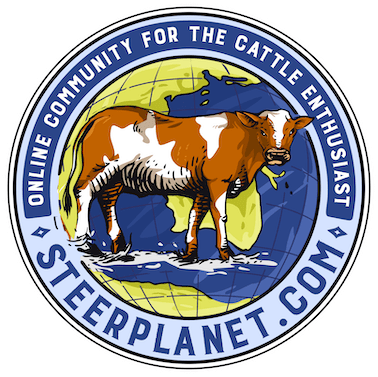I grew up in Bowden, Alberta and now live in Camarillo, California. I am down in California because I work for the navy on missile systems. California is a world apart from Alberta. In Souhthern California the attle business is treated like a hobby. Given the very expensive land and high cost of feed cattle are either treated as brush mowers on rough ground or dry lotted. Either way making money is a tough proposition here on cattle and the best ground is in vegetables, lemons, or grapes. The up shot is that productivity isn't a priority and getting over say $ 1,500 for a yearling bull is very hard. With most farm income not coming from cattle this is to be expected.
In Alberta is exactly the opposite in anything but the driest year feed and water are plentiful and the crops are feed crops- not suitable for human consumption. Frost damage is also a big risk and this means feeding light grain to cattle in order to market it. The average grade cow is around 1400 LB or more and she likely has some Hereford Simmental, Red Angus, or Charolais in her.. We feed at least from October 31 to May 1st or half the year. This is not range country. Given the long winter feeding period and the grass we have the rest of the year we demand our cows produce a big calf every year. This is why the Charolais is so important there.
The average fat steer in Canada is fed in a 100,000 head or greater capacity lot and is sold by sealed bid. The day of the 10,000 head lot selling on a day to day basis is long gone. The average steer is YG 2 select and is likley1250 to 1400 LB in size. The trade demands a leaner animal in Canada than you are used to. This makes their endpoint easier to obtain from an efficiency standpoint since lean is more efficient to put down.
The competition in 4H shows was brutal even at the pee wee level. We had a number of breeders with kids in the local 4H club that used to win Denver on a regular basis in the Hereford, Polled Hereford, Charolais, Angus, and Maine Anjou breeds. Frequently the heifer projects were part of the farms show string. The pressure on these kids was unbelievable. Given the drop in the rural population and the fact farm kids now play sports like other kids instead of show stock this a dying thing. Also purebred breeders found out that going to the expense of showing cattle did not improve their valve in the eyes of the commercial cattle man. He wants to use bulls where he can have a guaranteed market for his calves at a set price (CAB, Laura's lean etc.) so he can get a loan from a bank. Having a Grand Champion does not make a successful seed stock producer any more.
In Alberta is exactly the opposite in anything but the driest year feed and water are plentiful and the crops are feed crops- not suitable for human consumption. Frost damage is also a big risk and this means feeding light grain to cattle in order to market it. The average grade cow is around 1400 LB or more and she likely has some Hereford Simmental, Red Angus, or Charolais in her.. We feed at least from October 31 to May 1st or half the year. This is not range country. Given the long winter feeding period and the grass we have the rest of the year we demand our cows produce a big calf every year. This is why the Charolais is so important there.
The average fat steer in Canada is fed in a 100,000 head or greater capacity lot and is sold by sealed bid. The day of the 10,000 head lot selling on a day to day basis is long gone. The average steer is YG 2 select and is likley1250 to 1400 LB in size. The trade demands a leaner animal in Canada than you are used to. This makes their endpoint easier to obtain from an efficiency standpoint since lean is more efficient to put down.
The competition in 4H shows was brutal even at the pee wee level. We had a number of breeders with kids in the local 4H club that used to win Denver on a regular basis in the Hereford, Polled Hereford, Charolais, Angus, and Maine Anjou breeds. Frequently the heifer projects were part of the farms show string. The pressure on these kids was unbelievable. Given the drop in the rural population and the fact farm kids now play sports like other kids instead of show stock this a dying thing. Also purebred breeders found out that going to the expense of showing cattle did not improve their valve in the eyes of the commercial cattle man. He wants to use bulls where he can have a guaranteed market for his calves at a set price (CAB, Laura's lean etc.) so he can get a loan from a bank. Having a Grand Champion does not make a successful seed stock producer any more.
